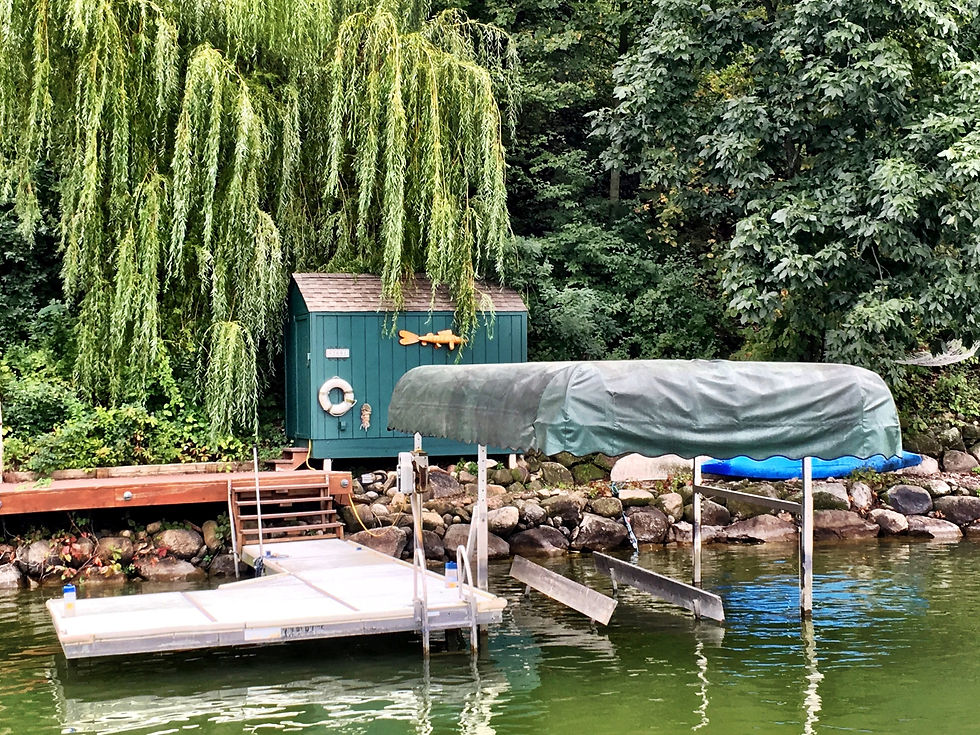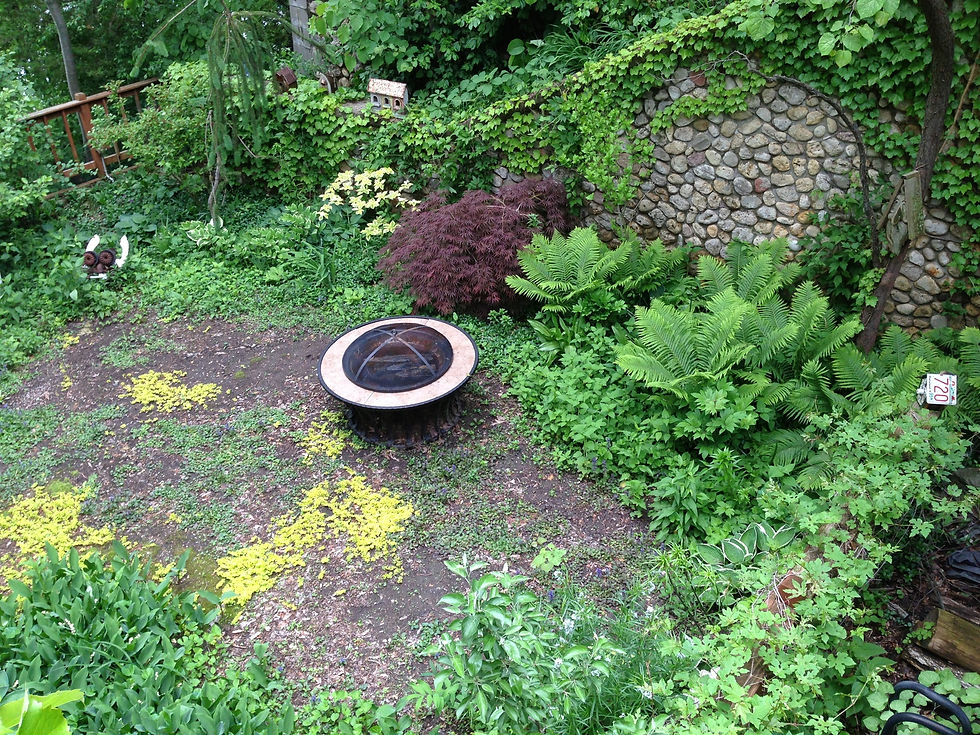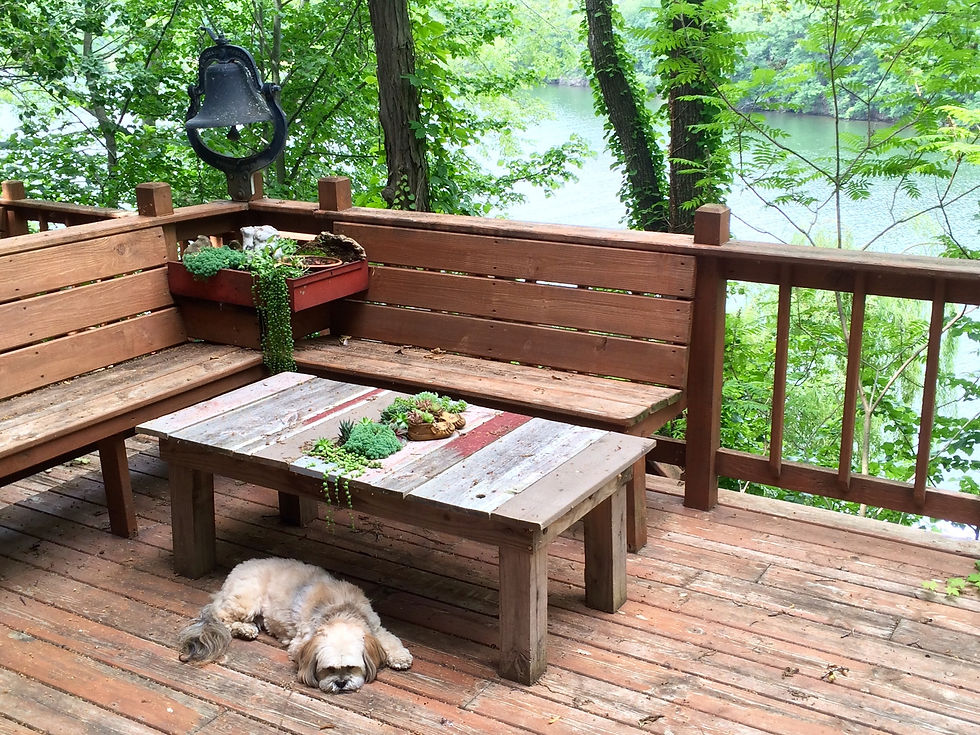Customize Your Lakefront Property to Fit Your Lifestyle
- Robert Sivek
- Dec 11, 2019
- 6 min read
Updated: Dec 16, 2019

When it comes to lake living, each and every family will have their own style. Depending on your lifestyle, there are countless ways to customize your lake home. Your lifestyle will influence your boat, dock, boat lift, fire pit, lighting, outdoor living, landscaping & gardens.
Boats
There are so many options to consider – fishing boats, deck boats, bowrider boats, ski boat, pontoon, sailboat, etc. Most boats fall into one of three categories: unpowered, sailboats, and motorboats.

To determine what’s right for you, ask yourself:
What type of recreational activities do you like? Some boats are better for fishing, while others will be better suited for skiing or wake boarding.
How many people will you typically take out on the boat? The amount of people will determine how large the boat needs to be.
What are the ages of your family and guests? Young children will want to swim, so you will need a ladder and ease access to/from the water. Adults may want a space to read or sun bathe. Others will want adventure - tubing, water skiing, wake boarding, etc.
Are there any boat restrictions on your lake? Local ordinaries will determine which types of boats you can use on the lake as well as other restrictions (i.e. lights, speed limits, etc.).
Is your lake depth enough and conducive for that type of boat? Make sure the lake is conducive for your boat. Pontoons are very common on Whitewater Lake, while speedboats are more common on Lake Geneva.
What kind of engine performance do you need? Inboard engine, jet propulsion, outbound engine, sail power, and sterndrive engine are few common types of engines. Each type of propulsion has its own unique advantages and disadvantages.
Do you plan on transporting your boat? If you plan on boating on different lakes, you will need a boat that can be transferred and the appropriate transporting equipment.
To help you get started, Discover Boating provides an awesome Boat Finder tool.
Docks & Piers
When it comes to lake living, it is essential that you are able to enjoy the lake. To get out on the lake, you will need a dock for your boat and other recreational activities.

To determine what type of dock is right for you, ask yourself:
How will you use the dock? How many and what type of watercraft do you have? How you use the dock and the number of boats you have will determine which style, size, and shape is best for you. If you just need to dock one boat, a simple, straight dock will suffice. If you want room to tan and bathe in the sun, then you might consider adding on a sundeck.
How much are you willing to invest in quality? Quality docks last longer and are safer. Also, consider the amenities you desire – built-in seating, a canopy, electricity, etc.
What accessories do you need? Consider which accessories are included and what you need to add-on. A few accessories you may want to consider include: boat bumpers, ladders, furniture, fishing pole holders, a kayak rack, etc.
Are there any dock restrictions on your lake? State or local regulations may restrict what type of dock is acceptable on that lake. The water level and waves will influence which type of dock is best.
How will the dock be maintained? Different types of docks will have different maintenance requirements. You should anticipate power washing plastic docks and staining wood docks.
Boat Lift
A boat lift raises the boat out of the water.

To determine the right boat lift for you, consider the following:
What size do you need based on your watercraft? Boat lifts are sized based on the amount of weight the lift can hold. It can range anywhere from 1,500 to 40,000 pounds.
What type of lift do you need? Bottom standing lifts work well if you have a fixed dock in shallow water (3-10 feet) and are ideal for lakes. Floating boat lifts are ideal when the water level fluctuates and a common in deep waters. Suspended lifts are better for average water depths.
Do you want a manual or electric lift? Electric lifts are convenient, but require a power source. Manual boat lifts are more affordable, but take effort to operate!
What is the average water level? The average water level impacts the type of boat lift. If the water is shallow, you will need to go with a sling style boat life, rather than a cradle style boat lift.
Are there any restrictions on thee lake? Some lakes do not allow a power source near the water, so a motor lift would no longer be an option.
How will the lift be maintained? There are many maintenance considerations including the overall infrastructure, the motor, the gears, etc. Make sure you know what you need to do to keep the lift functioning and safe.
Fire Pits
After a long day on the lake, wouldn’t it be nice to relax near the fire and enjoy s'mores? Even if you cannot have a traditional bonfire, there are plenty of fire pit options!

Here are a few questions to consider when choosing a fire pit:
Is there is space for a traditional fire pit or do you need to consider an alternative (ex: cauldron or bowl style fire pit)? Make sure to place your fire pit on a flat, inflammable surface at least 3 feet away from buildings, furniture, and branches.
What type of fuel will be used – wood, gas, or gel? Instead of the traditional wood-burning fire place, you could choose a gas or gel fireplace where you can easily turn it on/off and adjust the flame for your ideal lighting and heat.
What are the local fire regulations? Local and state ordinance may restrict the size and placement of the fireplace. Also, check on burning restrictions and know what you need to do before you burn.
Lighting
Landscape lighting can add ambiance, promote safety, improve security, and extend your time outside.
What do you want to illuminate? Consider what you want to illuminate- the dock, the fire pit, a walking path, steps, patio or seating area, etc. Alternatively, you might want to illuminate your home’s architectural features, landscape, garden, or water features. or ambiance, string lights are a great addition for patios.
What is the ideal size? Choosing too small of a light is a common mistake. Make sure the lights are large enough that they won’t get lost at a distance and will provide sufficient light.
Will you use uplighting or downlighting? Uplighting is great for highlighting plants, creating silhouettes, and creating dramatic shadows. Downlighting is great for accenting and drawing attention to small details.
Are power sources available? Make sure to consider the amount of power available. If there are not enough sources available, you may need to add additional resources.
Reflect on your answers to determine the best lighting for your property. Path lights can be used to illuminate a walkway, while sotlights can highlight outdoor features.
Outdoor Living
When it comes to outdoor living, consider how you can create additional living space outside your home. Outdoor living can provide a great space for entertaining, while increasing the value of your home!

How will you use the outdoor living space? If you love cooking, you may consider an outdoor kitchen. If entertaining is your priority, you will want more seating and coverage from the sun. If you want to upscale the space, consider water features.
How will the space be impacted by the weather? Consider how wind and sunlight will impact the space. A pergola can help create shade. Also, consider how much privacy you desire.
How will nature & bugs impact your time outdoors? Consider how to minimize the nuisance of mosquitos, bugs, and other outdoor critters. Mosquito netting is a great way to shield your patio or deck.
What utilities are available? Consider if gas, electric, or water is available. Make sure you install the necessary utilities! It is far more expensive to add a water line later.
What maintenance will be required? For example, concrete requires less maintenance than pavers.
Gardens
Landscaping and gardens can add beauty and nature to your property. However, there are special considerations for your lake home garden.
Are there any wildlife, environment, or landscape concerns? Closely examine the chemicals you use. These chemicals may become pollutants to the lake. For example, lawn care chemicals often contain phosphorus and nitrogen, which can seep into the lake and promote the growth of weeds and algae. Pesticides can harm fish and aquatic animals.

Are there any state or local regulations? Lake home properties are typically classified as floodplains. Floodplains may be subject to specific state and local regulations.
What type of maintenance is required? Low maintenance plants are often ideal for lake homes. These plants can survive and flourish with limited care and water. Make sure you consider how much care is involved, especially if this is a second home that you visit every so often.
How much are you willing to spend to maintain the garden? Consider how much care will go into the garden year after year. Some plants are fussier than others and require specific care, trimming, nutrients, etc. As an example, blue hydrangeas need a soil pH of 5.2 to 5.5. This means you will need to apply a Soil Acidifier every year in addition to the other routine care.
Boats, docks and piers, boat lifts, fire pits, landscape lighting, outdoor living, and gardens are just a few ways you can upgrade and customize your lakefront property. The possibilities are endless! The important thing is that you consider what is best for your lifestyle. Lake personalization is the norm.





Comments